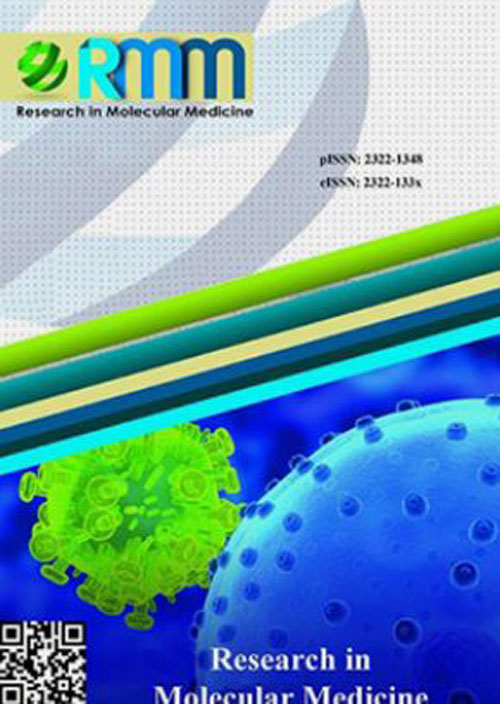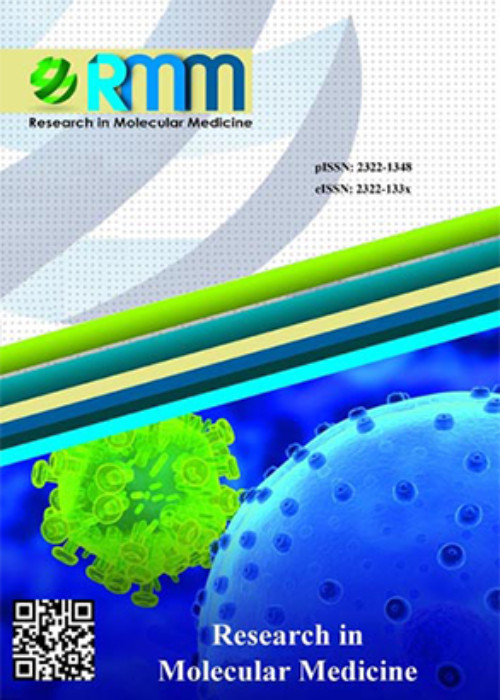فهرست مطالب

Research in Molecular Medicine
Volume:9 Issue: 1, Feb 2021
- تاریخ انتشار: 1400/04/20
- تعداد عناوین: 7
-
-
Pages 1-9Background
Interferon-gamma [IFN-γ) is the most important cytokine in the immune system. This protein has been expressed in bacterial cells. However, bacterial cloning is not an easy task. We aimed to clone, express, and purify recombinant mouse IFN-γ and overcome problems in favor of commercial purposes.
Materials and MethodsTo amplify the gene product for cloning, we primarily designed two specific primers for the target gene. Following PCR amplification, the amplicon was inserted into the pET-21b[+) vector. The E. coli BL21 [DE3) CodonPlus strain was chosen for the expression of the target gene. Finally, the expressed recombinant mouse IFN-γ was assessed through the western blotting method.
ResultsWe performed a cloning process and produced recombinant mouse IFN-γ in an optimal condition. We also noticed that monomeric protein could be transformed to a homodimeric structure which can be observed using the SDS PAGE [SDS-polyacrylamide gel electrophoresis) and western blotting.
ConclusionExperimental conditions strongly affect the large-scale cloning procedures required to be optimized in each laboratory. The expressed recombinant mouse IFN-γ described here is appropriate for commercial purposes.
Keywords: Cloning, E. coli BL21 (DE3) Codon-Plus, pET21-b (+) vector, Interferon gamma, Recombinant protein -
Pages 11-20Background
Breast and stomach cancers are the most common malignancies in Iranian females and males, respectively. Enriching with phytochemicals that have antioxidant and cytotoxic activities, extracts from dwarf elder (Sambucus ebulus L.) holds promises to be used for alternative medication.
Materials and MethodsWe investigated the cytotoxic and antiproliferative activities of the leaf and the fruit ethyl-acetate (EA), as well as the methanolic (MeOH) extracts of dwarf elder upon treatment of the MCF-7 and AGS cells. Twenty-seven concentration series ranging from 10 to 2000 μg/mL were administered to the cells, and their growth inhibitory potential was assessed using MTT assay. The potential anticancer compounds of the extracts were quantified applying an improved highperformance liquid chromatography (HPLC).
ResultsAll extracts showed positive dose-dependent cytotoxic activities on both cell lines. The EA extracts demonstrated more cytotoxicity compared to those of the MeOH ones (P<0.0001). The leaf EA extract showed IC50 values of 65 and 50 μg/mL, while those of the fruit were estimated as 58 and 50 μg/mL on the MCF-7 and AGS cells, respectively. The AGS cell line showed more susceptibility to all extracts tested compared to the MCF-7. MeOH extracts caused only a maximum of ~20% reduction in cell viability at 2000 μg/mL concentration. According to the HPLC analysis, leaf extracts contained phenolic compounds, including p- coumaric acid (0.10 mg per g powder), rutin (0.07 mg per g powder), and quercetin (0.02 mg per g powder).
ConclusionEA extract of the fruit shows the highest cytotoxicity: reducing 35.3% viability of the AGS cells with 10 μg/mL concentration. It can be considered a potential chemopreventive agent for cancer therapies. However, MeOH extracts with far low cytotoxicity or non-cytotoxic at some concentrations would be an appropriate candidate for preventing tumor growth without affecting neighboring normal cells.
Keywords: AGS, MCF-7, MTT, Plant extract, Sumbucus ebulus, HPLC -
Pages 21-27Background
Mitochondria are a source of reactive oxygen species (ROS), and several natural compounds are used as antioxidant agents. This study aimed to investigate and compare the effects of fresh grape juice red wine on oxidative stress biomarkers in rat liver mitochondria.
Materials and MethodsIn this regard, mitochondria were isolated from the liver of 27 male Wistar rats (220-250 g). The isolated mitochondria were cultured in different doses of red wine and fresh red grape juice for 24, 48, and 72 h. After treatment, total antioxidant capacity, lipid peroxidation, total thiol groups, and catalase activity were determined in the isolated mitochondria of the rat liver.
ResultsThe results confirmed the oxidant/antioxidant effects of red wine and fresh red grape juice at different times.
ConclusionAccording to the results, the fresh red grape juice showed higher antioxidant properties than red wine in the liver mitochondrial samples.
Keywords: Antioxidant, Grape juice, Liver mitochondria, Red wine -
Pages 29-38Background
Spermatogenesis associated 19 (Spata19) was introduced as a testis-specific gene that was probably involved in spermatogenesis cell apoptosis. Therefore, this study aimed to investigate the effect of Spata19 inactivation on sperm count.
Materials and MethodsWe generated global Spata19 knockout mice by CRISPR/Cas9 nickase technology. Disability was validated in three levels of DNA, RNA, and protein using PCR, RT-PCR, and immunohistochemistry. Histological studies were performed for testis. Sperm characteristics were also assessed with CASA software.
ResultsSpata19 knockout mice had a 43 nucleotides deletion in exon 4 of this gene. The presence and absence of Spata19 were confirmed in normal and knockout mice, respectively. The presence of Spata19 in normal NMRI mice was detected in the brain, heart, and thymus by semi-nested RT-PCR and in Leydig cells by immunohistochemistry. Histological studies revealed a decrease in sperm count in knockout mice. Also, CASA parameters were significantly reduced (P<0.05).
ConclusionThese data indicate that Spata19 inactivation is a cause of oligospermia, and its role could be beyond an adhesive molecule.
Keywords: spermatogenesis associated 19 (Spata19), CRISPR, Cas9 nickase, global knockout mice, oligospermia, infertility, spermatogenesis, outbred mice -
Pages 39-49Background
Rhamnolipids are hydrophilic glycolipids, often classified as biosurfactants. They are produced by different bacterial species. Rhamnolipids are extensively studied in biological research because of their interesting features like antimicrobial, antifungal, and antiviral activities.
Materials and MethodsTo study the antimicrobial effect of rhamnolipid, we conducted a crosssectional study on the eight different pathogenic bacterial strains from November 2019 to June 2020. These bacterial strains were isolated from the organic compost. Both disk diffusion and broth microdilution methods were used to evaluate the inhibitory effects of rhamnolipids on these pathogenic bacteria. Also, protease and amylase enzyme activities were evaluated in these eight bacterial isolates.
ResultsFor Bacillus stearothermophilus, within the area of 31.5 mm, no growth was observed, hence proving the inhibitory effect of rhamnolipid. After calculating the minimum inhibitory (MIC) and minimum lethal concentrations (MLC) for each bacterial strain, it has been found that the studied bacteria were more susceptible to rhamnolipids than most of the antibiotics. Strains were also quantified for their enzymatic activity of proteases and amylases. The bacterial strains of Bacillus stearothermophilus, Brevibacillus brevis, Bacillus licheniformis, and Bordetella petrii showed maximum protease activity. Whereas Escherichia coli, Enterococcus faecalis, Enterobacter aerogenes, and Pseudomonas aeruginosa showed high amylase activity.
ConclusionRhamnolipids can be used as a potential antimicrobial agent for treatment of infections.
Keywords: Rhamnolipid, Surfactant, Antimicrobial, Bacillus stearothermophilus, Protease -
Pages 51-60Background
Vitamin D plays a key role in the modulation of numerous immune functions against infectious agents. We aimed to explore the association between serum 25‑hydroxyvitamin D (25[OH] D) levels and cytokine responses, along with hematological changes, in patients with urinary tract infection (UTI).
Materials and MethodsVitamin D level, cytokines (interferon [IFN]−γ, interleukin [IL]−4, IL−6, IL–10, IL−17A, tumor necrosis factor [TNF]−α, and transforming growth factor [TGF]−β), hematological indices (neutrophil-to-lymphocyte ratio [NLR], monocyte-to-lymphocyte ratio [MLR], neutrophil-to-monocyte ratio [NMR], platelet-to-lymphocyte ratio [PLR], and mean platelet volume [MPV]), C-reactive protein (CRP), and erythrocyte sedimentation rate (ESR) were evaluated in a case-control human study included 65 patients and 45 controls.
ResultsAmong the enhanced cytokine levels in patients, the cytokines IFN-γ, IL-17A, and IL-10 had a significant association with 25(OH)D, but not IL-6, TNF-α, and TGF-β. The IL-4 levels remained unchanged. By comparing hematological indices, we found the association of increased NLR and MLR with 25(OH)D and the cytokines IFN-γ and IL-17A, along with a decrease in the PLR without showing such an association. The NMR did not show any significant difference. The platelet count showed an association with IL-6, IL-17A, and TGF-β, but the association of MPV with 25(OH)D was significant. The ESR results exhibited statistically non-significant differences. CRP elevation was directly associated with IL-6 and IL-17A, but not with 25(OH)D.
Conclusion25(OH)D-mediated inflammatory cytokine milieu might alter the proportion and function of peripheral blood cells in a regulated manner to support bacterial clearance which needs further studies to be validated.
Keywords: Cytokine, Inflammation, Leukocytes, Platelets, Urinary Tract Infection, Vitamin D -
Pages 61-69Background
Age-related macular degeneration (AMD) is the leading cause of vision loss in the elderly. Although it has been shown that Y402H polymorphism in the CFH gene was strongly associated with AMD in the Iranian population, there were no data on other single nucleotide polymorphisms (SNPs), which have the most significant association with AMD. This study aimed to investigate hot point regions in exon 10 and intron 9.
Materials and MethodsOne hundred and sixty-six AMD patients and 69 controls were recruited. Their blood was collected in the tubes containing EDTA. Then, DNA was extracted from the blood, and its quality was evaluated. Primers were designed for intron 9 and exon10 sequencing. A viral polymorphisms analysis software named CEQ was used for the analysis of putative polymorphisms.
ResultsWe noticed three polymorphisms in study cases: rs7535263 and C66379A in intron 9 and rs2274700 in exon 10. Based on the McNamara’s test (rs7535263 and rs2274700) and the Phi and Cramer’s test (C66379A), a significant difference was found between the control and patient groups regarding rs7535263 and rs2274700 polymorphisms.
ConclusionWe found a synonymous or silent mutation, A473A, rs2274700 in exon 10 in 85% of patients. From two intronic SNPs, just rs7535263 showed association with the disease in studied patients living in Gilan Province, Iran. Although no significant relationship was found between controls and patients regarding the C66379A allele, it would be important that no other sources have reported C66379A polymorphism in AMD yet.
Keywords: AMD, CFH, SNP, exon10, intron 9


